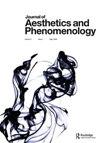Review: John Sallis’ Songs of Nature, on Paintings
IF 0.2
0 PHILOSOPHY
引用次数: 0
Abstract
expressionism played in the artists’ development, particularly through the works of Wassily Kandinsky. In Western history, the period of the avant-garde provoked a conscious rupture with the traditional canons of art, erecting a partition where artists could work beyond the imperative of objective representation. Sallis expounds on the influence and the affinity of Cao Jun’s paintings with Western artists such as Kandinsky, Klee, Cézanne, and Monet, noting how the atmospheric spread of light and the constant hovering between abstraction and figuration allows the observer’s imagination to wander throughout the painting. Sallis focuses specifically on the artist’s Sea of the Sky, which, in his view, affords an intriguing comparison with Kandinsky’s series of Compositions. The free flow of colours, the sharp contrasts of volumes and shapes and the overall sense of rhythm and dynamism seem to corroborate Cao Jun’s own statement that, in his paintings, “Eastern imagism and Western abstraction are fused.” In the context, Cao Jun paints, and Sallis interprets, the talent of an artist does not consist in an act of creation, but rather in the attunement with the inner vitality of the cosmos, bringing about the spontaneous emergence of scenes that would otherwise remain invisible. These scenes are not meant to represent a specific place or event, but to offer a contingent, tangible form to the ceaseless process of transformation animating nature. The second chapter is dedicated to Spaces. In Cao Jun’s paintings, shapes often appear without a discernible order. Shapelessness and shiny surfaces create a dreamy expanse that can be interpreted as the creative manifestation of unconscious thought: “Even though translating the latent content or dream-thoughts from their hidden depth, the space of the dream itself, of its manifest content, is replete with shining images.”(p.35) Nonetheless, the indeterminate nature of the dream space is always counterbalanced by a determinate figure that accentuates the sharp contrast between being and becoming. At times, this figure corresponds to a lion, a tiger or another wild animal, which may be equated with the brave and solitary work of the artist or, more generally, to a visionary depiction of the beauty of wilderness, such as in National Spirit and The Return of the King. Sallis also notes the increasing attentiveness to nature, influenced by the study of Dutch landscape painting. The necessity of obscuring specific elements and areas of the landscape in order to evoke distance and depth evokes a direct connection with traditional Chinese painting techniques. Color-splashing works as an additional means to structure spacing and perspective in Cao Jun’s paintings, as in Misted Mountain and Trees, where the diagonal color-splashed area “counters somewhat the pure verticality of the scene and is complemented by the reduction in the prominence of the master mountain.” In the adoption of this fresh 174 BOOK REVIEWS评:约翰·萨利斯的《自然之歌》
表现主义在艺术家的发展中发挥了作用,尤其是通过瓦西里·康定斯基的作品。在西方历史上,先锋派时期引发了与传统艺术准则的有意识的决裂,在那里艺术家可以超越客观表现的必要性。萨利斯阐述了曹骏绘画与康定斯基、克利、塞尚和莫奈等西方艺术家的影响和亲和力,指出光的大气传播以及在抽象和具象之间的不断徘徊使观察者的想象力在整个绘画中漫游。萨利斯特别关注这位艺术家的《天空之海》,在他看来,这本书与康定斯基的一系列作品进行了有趣的比较。色彩的自由流动、体积和形状的鲜明对比以及整体的节奏感和动感似乎证实了曹骏自己的说法,即在他的绘画中,“东方意象主义和西方抽象主义融合在一起。”,而是在与宇宙内在活力的协调中,带来原本看不见的场景的自发出现。这些场景并不意味着代表一个特定的地方或事件,而是为自然界不断变化的过程提供一种偶然的、有形的形式。第二章专门讨论空间。在曹骏的绘画中,形状往往没有明显的顺序。无形和闪亮的表面创造了一个梦幻般的广阔空间,可以被解释为无意识思维的创造性表现:“即使从隐藏的深度翻译潜在的内容或梦的想法,梦本身的空间,其明显的内容,充满了闪亮的图像。”(p.35)尽管如此,梦境空间的不确定性总是被一个确定性的人物所抵消,这个人物强调了存在和成为之间的鲜明对比。有时,这个人物与狮子、老虎或其他野生动物相对应,这可能等同于艺术家勇敢而孤独的作品,或者更普遍地说,等同于对荒野之美的富有远见的描绘,例如在《民族精神》和《王者归来》中。萨利斯还注意到,受荷兰风景画研究的影响,人们越来越关注自然。为了唤起距离和深度,有必要遮蔽风景的特定元素和区域,这与中国传统绘画技术有着直接的联系。在曹骏的作品中,泼墨是结构间距和视角的一种附加手段,如《雾山与树木》中,对角线泼墨区域“在一定程度上抵消了场景的纯粹垂直性,并辅以大师山的突出度降低。”
本文章由计算机程序翻译,如有差异,请以英文原文为准。
求助全文
约1分钟内获得全文
求助全文

 求助内容:
求助内容: 应助结果提醒方式:
应助结果提醒方式:


